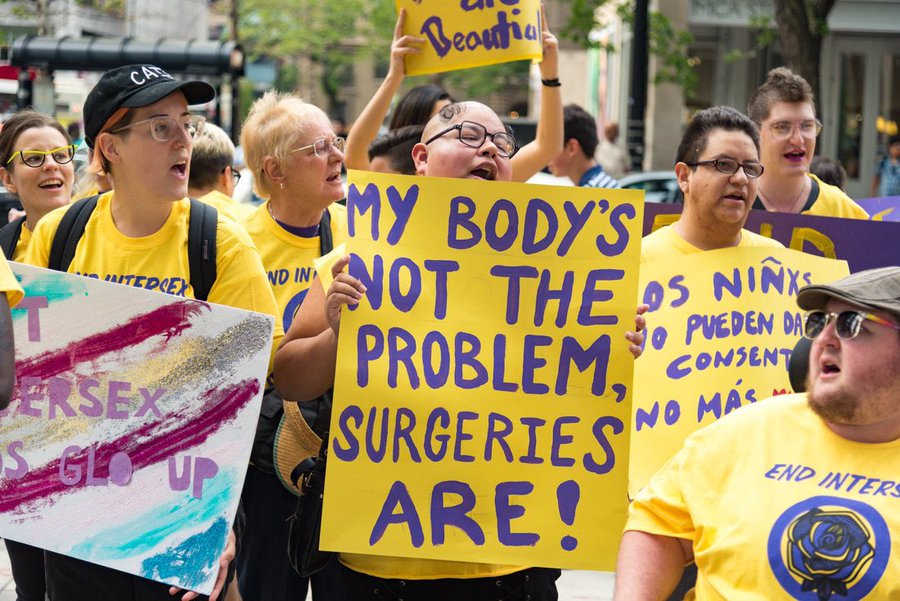Intersex Justice activists protest non-consensual surgeries on intersex people. (IntersexJustice/ Twitter)
Intersex people have been around for as long as humans have, yet they’ve been shrouded in secrecy and ignorance for much of our history.
The truth is that these traits are perfectly natural and far more common than many people realise. Up to 1.7 percent of the world population is born intersex, a figure roughly equivalent to the number of redheads.
Nowadays, growing numbers of intersex people are casting aside the historical stigma and proudly embracing their identity as members of the community. Here’s a breakdown on what it means to be born outside the gender binary.
What is intersex?
Intersex people are born with a particular set of sex characteristics — such as chromosomes, genitalia, reproductive anatomy and hormones — that don’t fit neatly into typical binary categories of male or female.
Some of these traits are visible while others are not. Some are obvious at birth, some become apparent during puberty or later in life, and some are never discovered at all. Most traits are random, although some do run in families.
These biological variances occur naturally in humans and there are over 40 medical terms under the intersex umbrella for the different ways sex anatomy might develop.
That means there is no one way to “look” intersex. An intersex person may have female chromosomes but ambiguous to male-appearing genitals, or male chromosomes but ambiguous to female-appearing genitals.
They could have what’s called “true gonadal intersex”, which means they have both ovarian and testicular organs, or they could have a complex or undetermined form of sexual development that doesn’t fit neatly into any of these categories.
As the Intersex Society of North America wrote over 20 years ago: “Nature doesn’t decide where the category of ‘male’ ends and the category of ‘intersex’ begins, or where the category of ‘intersex’ ends and the category of ‘female’ begins. Humans decide.”
How common are intersex people?
According to campaigners, annually around one in 2,000 live births have these characteristics, and one in 200 of these babies are born with visibly variant genitalia which don’t fit typical binary definitions of male or female.
This amounts to roughly 1.7 per cent of the world population, which makes intersex people about as common as those with red hair.
But the true figure is hard to ascertain since most intersex people don’t have characteristics that are externally visible. Others have their genitalia altered at birth, so some may never know they are a part of this community.
What happens if you’re born intersex?

In most cases these traits are totally harmless, and intersex people can live a happy and healthy life with little or no medical intervention.
But for decades surgeons have attempted to “fix” intersex babies with medically unnecessary surgeries to alter the size or appearance of genitals before the children are old enough to meaningfully consent.
Between 1930 and 1960, various forms of genital reconstructive surgery were pioneered by doctors whose understanding of these conditions was relatively primitive, and whose main motivation was to make the child’s appearance more “typical” of the gender binary.
These invasive procedures include clitoroplasty, vaginoplasty, phalloplasty and gonadectomy, and they are frequently performed on intersex babies to this day.
While some are done to reduce the likelihood of future problems, surgical intervention is usually only necessary in the rare case that an infant is unable to urinate. Often it is the surgeries themselves that cause health issues.
Many adults are left with scarring, incontinence or loss of sexual feeling, while the removal of testes and ovaries results in involuntary sterilisation which may require lifelong hormone replacement therapy.
The community has long called for an end to these operations, pointing out that they have high complication rates and can lead to painful physical and psychological problems in later life.
It looks like we could be on the cusp of a watershed moment for intersex rights as a growing number of medical bodies opt not to perform the procedures, but there is still a long way to go.
Is intersex is different from transgender?
Yes! The two terms are often confused but they are not the same and shouldn’t be used interchangeably.
The key difference is that a trans person has a gender identity that differs from the one they were assigned at birth, whereas an intersex person was born with physical variations to their sexual or reproductive anatomy which mean they don’t fit typical definitions of “male” or “female”.
Intersex people can have any sexual orientation or gender identity. Both intersex and transgender people can identify as men, women, gender-fluid, non-binary, or in a multitude of different ways.
How can I be an ally to intersex people?
For starters, don’t reinforce the belief that they need to be fixed. Instead of pushing “normalising” surgeries, parents and doctors should give intersex children the autonomy to decide when they’re older.
“The most important thing would be to advocate for people to make their own choices about their bodies. The person having that intervention has to have some agency in the decision,” said Dr Arlene Baratz of the Androgen Insensitivity Syndrome-Disorder of Sex Development Support Group, speaking to Health.
Be careful about the terminology you use when referring to intersex people. Historically the term “hermaphrodite” was often used, but many intersex people now find this word insulting and an inaccurate description of intersex bodies.
And finally, don’t ask invasive questions about their bodies – you wouldn’t normally strike up a conversation about a person’s genitals, and intersex people are no different!
